My parents bought their current house in 1999 and, for the first few years that they lived there, there wasn’t a lot of it. Due to the limited space upstairs, when I came to stay I slept on a couple of large sofa cushions in the tiny living room, in which I felt I could sense the ghost of the house’s previous owner, Dorothy House, who had died there on her hundredth birthday. Because Dorothy House had lived in the house her entire life – first with her parents, then with her husband William who ground ball bearings for a living, and then alone – and because it had never been my childhood home, I found it a little difficult to initially perceive it as truly my parents’ house. The fact that Dorothy House had the word “House” in her name seemed to somehow underline the sense that the building was still hers. Upstairs in Dorothy House’s house, there was one small bedroom and one smaller bedroom, which my dad used as an office. Downstairs, behind the stairway and a medium-sized kitchen – the only non-tiny room in the house – there was a narrow utility room, and it was in here, during the middle of the first decade of this century, sandwiched between the washing machine and fridge, that, very quietly, my mum started creating pieces of art. I became aware of this not because my mum had said “Look at this painting I did” but because the art, quite quickly, and in ever increasing quantities, began to appear around the house. “Is this yours?” I would ask, and my mum would confirm that it was.
What had prevented my mum making the art she wanted to during the first five and a half decades of her life? Pretty much the same stuff that stops endless amounts of people fulfilling the more creative life they desire: a tiring full-time job, the concomitant extra job of being a good parent, house moves and house renovations, a lack of self-belief rooted to an extent in class and background and place. Throughout my childhood, in addition to his work as a supply teacher, my dad sold paintings to galleries, then, in his late 40s, began to write children’s books, but I had no idea about my mum’s artistic desires, as she never mentioned them. When I did become aware of them, it was not because of the volume at which my mum talked about her ambitions, but because of the volume of her output. All of a sudden the house was full of art. Actually, the house had always been full of art – most of it my dad’s – but now it was full of even more.
I always liked my dad’s landscape paintings as a child, but it’s only now that I appreciate their fine detail on a higher level: the astonishingly intricate winter trees of his Peak District hillsides, a bucolic yearning for an unspoilt place that’s very him, combined with a slight rawness, an absolute refusal to be at all twee, which is also very him. He’s a little dismissive of these paintings now at times, preferring to concentrate on his blackly comic and more free-flowing new direction: nightmare vistas, grotesque faces, dark mind maps, and twisted reimaginings of popular legend (‘The Tickling To Death Of Jesus’, ‘Winnie The Pooh And Tigger Get Assassinated’), plus – on a lighter note – the new ‘Slow Down For Ducks’ sign that he was commissioned to paint for the village last summer. But my dad is still arguably the traditionalist in the house. A look around my mum’s work room – her new work room, behind the old work-and-utility room, where a couple of Dorothy’s old sheds used to be – this Boxing Day revealed, to name just a few: screenprints of dried flowers, an embroidery of my cat Roscoe, a still life of flowers and a mid-century jug, charcoal drawings of fish in a frying pan, various abstract landscapes, an athletic man made from a coat hanger, a collagraph of a hare in woodland and a linoprint of another more medieval looking hare, with just a touch of automata about it. And I’m just talking about the output I hadn’t seen before.
“And since he didn’t know he couldn’t fly, well of course he did/ ‘Cause he’s one of those who knows his life/Is just a leap of faith/Gotta spread your arms and hold your breath and always trust your cape,” Jerry Jeff Walker sings, on his 2001 song The Cape. When my mum remembers the way she started with her art, after decades of working as a primary school teacher in Nottingham, it’s a song – the Guy Clark version, specifically, and mainly that line about flying because you don’t know you can’t – that she often thinks of. As well as being about faith and self-belief and some of the stuff society erroneously tells us will be sapped from our lives as we get older, it is also, I think, a song about magic – an intangible something we need to trust we can tap into, whenever we’re doing anything brave. “I’d been doing art with kids every day of my life, but it occurred to me I’d never painted a picture myself,” she told me recently. “So I sat in the garden and painted the picture.” This would have been in 2005 or 2006. She framed the finished article, an acrylic rendition of some aliums she’d planted nearby, in a wooden frame bought from a flea market, also painted by her. She thinks that she was steered towards painting actual pictures by intensive home decorating and upcycling furniture: years of rag rolling, vinegar painting and wood-grain stencilling bits and bobs she would magpie from carboot and jumble sales. There are few forms of art she hasn’t experimented with in the last decade. She has also run and attended art classes, including life drawing. On one occasion, the model turned out to be a well-known local postman.. “EVERYONE RECOGNISED HIM BY HIS SACK,” my dad interjected, when my mum told me the story.
So much about a visit to my parents’ house now feels tinged with my mum’s creativity. As I opened my presents from my parents this year, I noticed each included a beautiful tag, with a new print by my mum on it. Hares, medieval carol singers. “IF LIBERTY SOLD THESE THEY’D CHARGE A FOOKIN’ BOMB,” said my dad. My parents both came up with homemade Christmas cards this year. My mum’s was a print of a robin; my dad’s was a maelstromic cave painting, featuring Santa Claus on his sleigh, pulled by three reindeer, charging through a fire and brimstone landscape of hunter-gatherers and wild animals. I liked them both a lot, in very different ways. My mum’s art room is beautifully light and high-ceilinged and significantly more welcoming than my dad’s office, but it is hard to argue that there is any injustice in this, since for years my mum didn’t have a proper art room at all, and if my dad did have an art room as nice as my mum’s he would soon undoubtedly make it less nice by depositing mud from the garden, maps, bathwater-soaked paperbacks and half drunk cups of coffee all over it.
My mum stepped up her work-rate considerably around 2013, not long after her studio was built, in the space behind the narrow utility room, where a couple of Dorothy’s sheds had previously stood. I also played a small part in her new zeal for creativity. That year, which was also the year I went from feeling like I wasn’t going to be permitted to write a books ever again to getting on the Sunday Times top ten bestseller list, with a book that some people presumed was about cats but actually wasn’t but also actually was, my mum started to send me illustrations she’d done of my cats. The first of these was a very quickly executed monoprint of two versions of my cat The Bear, which came out of a conversation we’d had about his owl-like spirit, and – despite being extremely minimalist – perfectly captured a couple of his most familiar expressions: sweetly hopeful, and consumed with obvious worry about the entire universe. Linoprints and embroideries of The Bear – plus my other cats Ralph, Roscoe and Shipley – followed and to look across the span of these is to see a graph of my mum’s style being honed. Soon, the Welsh publisher Graffeg began to sell posters, cards and calendars of her work. In 2017, my mum contributed twenty one nature linoprints to my book 21st-Century Yokel and, this year, another twelve to the follow-up, Help The Witch. She turned down my request for her to illustrate the covers for the books, on the – incorrect, I feel – grounds that “your book needs the maximum chance to do well and if I illustrate the cover it won’t have that.”
After almost half a decade of my readers purchasing my mum’s art, I have finally just about convinced her that this happens not solely because people like my work and see her as an extension of it. I have no doubt at all that many people who have read my books now get far more excited at the prospect of a new print by my mum than they get by the prospect of a new book by me. “Eek! All those years and I haven’t done enough,” she said, when, during the writing of what you’re now reading, I asked her to verify the year she retired. How much more, I wondered, does she think she could have done? Her work rate is already astonishing, particularly considering the severe arthritis in her hands, which makes many of the printmaking techniques she uses – including the cutting of lino – more painful and arduous for her. After dinner last Thursday, while my dad hassled a BT man who was fixing their line, she handed me some “spare” pieces of her work which she deemed “not quite good enough to sell”. I peered forensically at the ink but could not see a fraction of anything wrong with any of them. It’s frustrating, dealing with someone who operates on this level of perfectionism, but I can hardly speak, since I suffer from a similar affliction. The part of me that, even though he has published two books in two years – two of the kind of books he’s been waiting years to write – is slightly miffed with himself for not publishing three or four books during the same period: that is one of the parts of me that’s my mum. The part of me who sees a criticism of his work and, even though the criticism comes from someone who hasn’t read his work or has read his work and is the kind of person who would never appreciate it, thinks, “Right. I’ll just have to try harder and write better stuff, then!”: that is also one of the parts of me that’s my mum. When you consider that my dad is a perfectionist too, it’s obvious I never really stood a chance. But, of course, I would not have it any other way for all the world. Being more of a massive bastard to myself – within reason – is why my more recent books are better than my earlier books. I also can see a way that the work my mum has done for my books in itself has made me more of a perfectionist. It’s so good, it makes me want to raise the standards of what I do to meet it.
I am sure I was like my mum and dad in lots of ways in my 20s, but I noticed a few of the ways became more acute as I hit my mid-late 30s. Like my dad, I became more dopey, more talkative, more heavily into firewood, and started to have an urge to swear every time I sneezed. Like my mum, I became more shy, harder on myself, more abstract in my interests, more keen to learn. Shyness is rarely simple, and comes in many disguises. I did 23 spoken word events this year, to audiences of anywhere up to 300 people, and at each one – apart from maybe the three where I was super ill, and one where the stuck-up woman on the gate at the festival wouldn’t let me and my friend in and seemed to think we were lying about who we were – I was as relaxed as I would be talking to three friends in my own living room. I enjoyed it all. But at the same time, I feel less keen than ever to be any kind of public face as an author, more uncomfortable than ever when people recognise me for a vague notion of my work. Just as I’ve got good at public speaking, I find myself wanting to do less of it – on social media, as well as in person – mainly for the simple fact that I don’t ever want to put it above the pursuit of real creativity. On days when I feel like I’m resting more on what I’ve done as a writer – touring it, waiting for feedback on it – than what I’m about to do as a writer, I feel a little lopsided, a little wrong, even a little queasy. It would be absurd to say that my mum didn’t want or appreciate feedback on her work, but for her the ultimate pleasure is always in the work itself, shutting herself away and getting lost in it. I relate more to that than ever.
I owned a couple of capes as a kid and, though I went a long period without owning a cape, I now own a couple of capes again. I don’t think I’ll ever be a full-time Cape Guy, but I like wearing them for special occasions, not all of which involve large gatherings, or – actually, come to think of it – any gathering at all. I’d hate to think that there might ever be a point where I would stop ever wanting to wear a cape. I have a lot of trust in capes, generally. It was actually the exact time that I started to enjoy my work more, and started to take a different level of pride in it, that I acquired my first adult cape, but I think that is probably just a coincidence. The last cape I’d had before that was when I was about nine. It was light blue with a red “T” that my mum had added to the back, using her ancient Singer sewing machine. After I’d flown around the garden for a few hours in it, being a superhero – presumably, going on the logo, a fairly mundane East Midlands one just called “Tom” – I’d often spend the rest of the day indoors, writing or drawing. My mum and dad might have nudged me towards both the latter activities but they didn’t have to nudge me very hard; I was always enthusiastic. I remember the feeling of total immersion, losing track of time, feeling that, when I came out of my writing or drawing because it was time for tea or to go out to my nan’s or to go to play badminton at the leisure centre, I was waking up from a dream. I think my working method resembles this more now than it ever has in my adult life. But I’m not the only one, and I don’t think I could even claim that, of my family, I’m even the most immersed. Some people go on fancy holidays in their retirement; my mum and dad – when they’re not gardening – paint, write and draw. “What have you been up to today?” I’ll ask my mum. “Art,” she’ll reply. “What about dad?” I’ll say. “Art,” she’ll reply. Sometimes I wish they’d treat themselves to a few days away somewhere hot, doing absolutely nothing, near some swimmable water, but doing absolutely nothing is not in their nature, and they seem happy. There they’ll be, lost in their imaginations, in this house that now seems so much more theirs: my dad in his office, upstairs, and my mum in her lovely, light room, where Dorothy’s sheds used to be. Then, as if by magic, it will be several hours later, and time for tea.
My mum’s Etsy page can be found here, and here cards, posters, mugs and calendar for Graffeg are here.
You can purchase a special edition of my upcoming book, Ring The Hill – which will also feature some of my mum’s art – here.
My latest two books are Help The Witch and 21st Century Yokel, which both also feature my mum’s art.

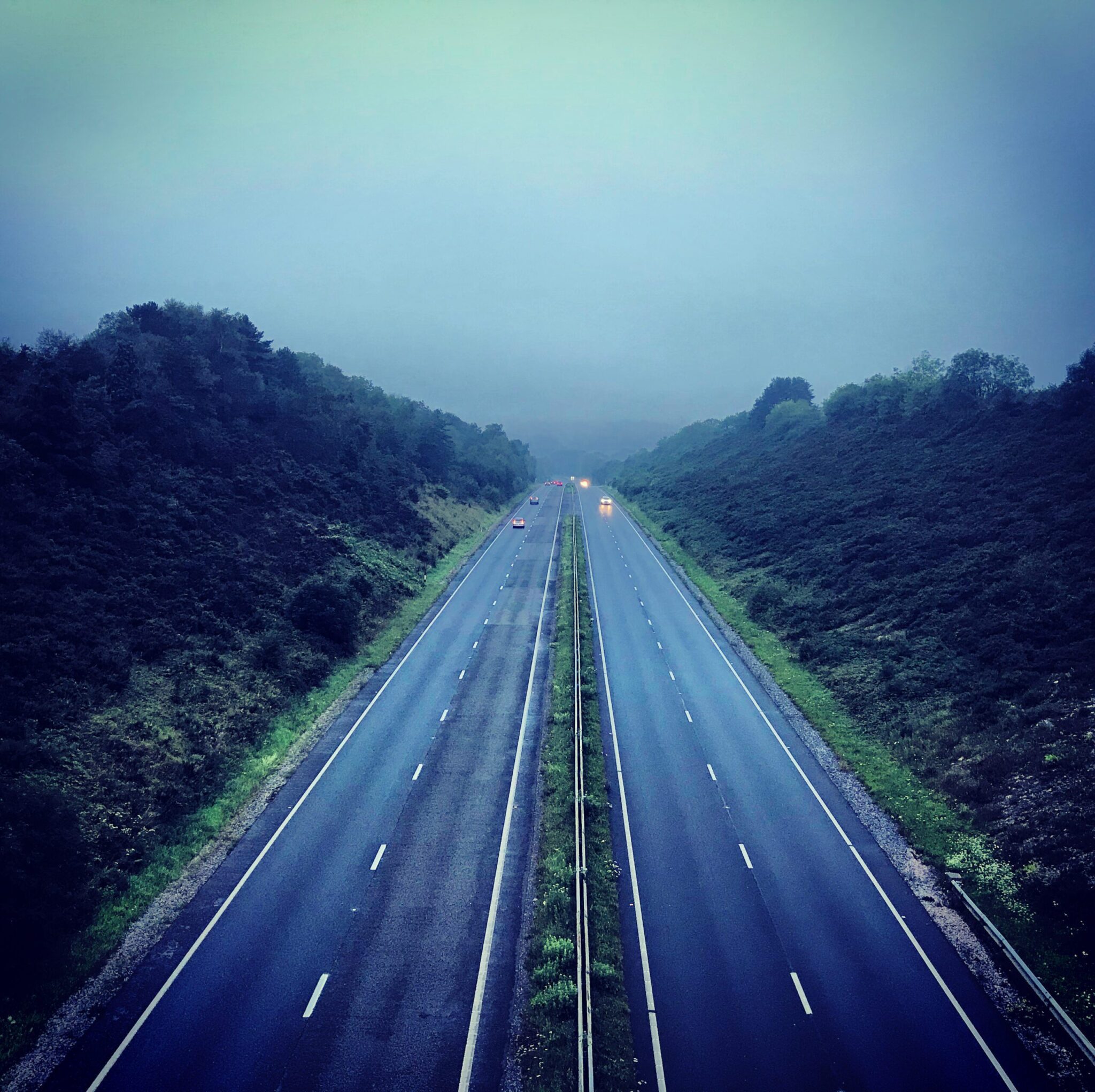
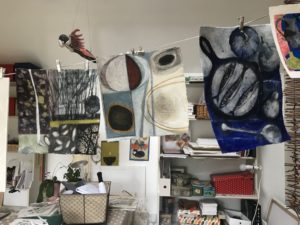
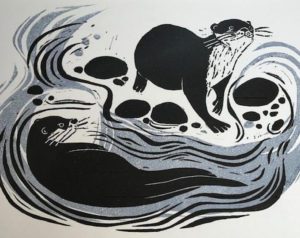
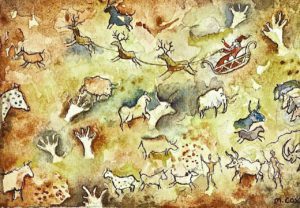
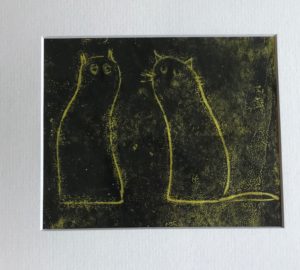
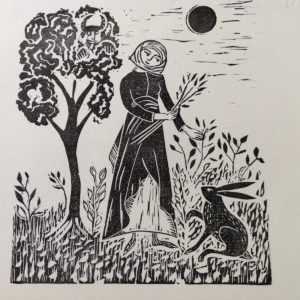
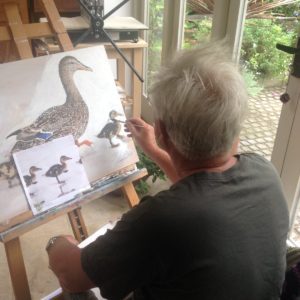
I adore your mum’s art, and your Dads, tell your Mum I buy her art because it speaks to me, not because she’s your Mum. Though that is something to be proud of, I don’t simply buy art because my favourite authors Mum happens to be an artist.
I so very much second this.
Me too! Also I used to teach Nottingham, (Berridge Infant School) and it makes me happy to imagine I met your mum at some point!
Last year’s Jo Cox calendar has been taken down I’ve just bought the 21st Century Yokel one to replace it. I also got one of your Mum’s mugs – The Plight of the Bees. I used to keep bees many years ago & maybe this will urge me to get back into it again! I’m sure The Bear would have wanted me to. 🙂 xxx
I also love your mom’s (and dad’s!) art. I have the plague doctor and would love to purchase the Otter. I will keep my eye out in her shop!
Thank you for this piece Tom. I’m just finishing a 9 month career break to publish my novel and I completely agree with you about the time just disappearing when your writing. I think we all need to make time for our art, whatever it may be, to find that place within us where the magic happens. And your Mum’s artwork is amazing, the pieces are so individualistic and touch the heart. Such a talented woman (and her son’s not too bad a writer either:)).
This is fantastic!
Tom, this is a gorgeous piece about your folks, and especially about Jo. Having known them both since 1970 it is lovely to read about how Jo’s art has come about, and is flourishing. Whenever we have visited them from Australia I am always in wonder at Jo’s art work – the skill and the variety. I am so happy to have some of her original pieces hanging in our house and just wish I lived closer so I could see more! As you say too, Jo struggles with arthritis in her hands, but you would never know it – her work is truly a work of love. Thank you so much for sharing this piece. It brought tears to my eyes – on many different levels – Jo’s modesty, my own lack of belief in my small pieces of creativity, the lack of belief in those I see around me with so much talent, and of course, the pieces you say you have inherited from each of Mick and Jo. What a wonderful family.
I remember in 1972 when Jo was a student and decided to do pottery as an option, with no prior skill, and started producing beautiful little pots (one of which we still proudly own and display).
I remember in 1972 when Jo was a student and decided to do pottery as an option, with no prior skill, and started producing beautiful little pots (one of which we still proudly own and display).
It was your mother’s artwork that led me to your writing.
Love you both 🙂
Thank you for sharing this! Love both your parents’ art work!!
“It would be absurd to say that my mum didn’t want or appreciate feedback on her work, but for her the ultimate pleasure is always in the work itself, shutting herself away and getting lost in it. I relate more to that than ever.” This is what makes art brilliant.
I really hope your mum will create the illustrations for Ring The Hill, and this time design the cover too.
What a wonderful story. I have started doing watercolours since I retired and it’s lovely to see how much this development has delighted and intrigued my children.
Tom, I loved reading about your mum, my dear cousin. She’s very talented. Sending her my love x
You can keep your Hollywood superstars. You, your Mum and your Dad would be my fantasy dinner party companions. I think that’d be much more fun.
Oh my goodness me – yes!
What a lovely post with a heartwarming and inspiring story. It has taken me until my forties to really start doing drawing and making (though have always written sporadically and mostly just for me). It’s a struggle, as I’m still working and bringing up children, but I think once you set your mind to doing something new avenues open up. Others around you may also then become inspired. Bought a book on making bracelets and my husband and I made four beaded ones yesterday (new to him too and he really enjoyed it). No doubt you have been very inspired by your parents’ work (Love it all! From the minimalist but soulful cats to the lively Christmas cave painting – so much originality there too).
Haven’t read any of your books yet, but your tweets and this blog post are certainly encouraging me to do so! Keep up the great work!